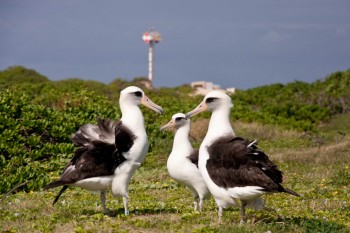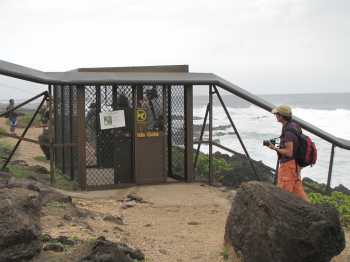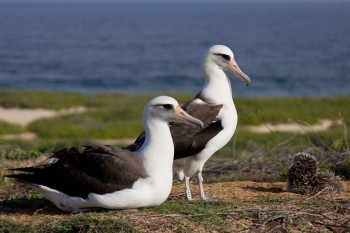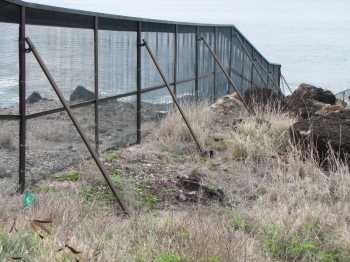
A small group of Near Threatened Laysan Albatrosses Phoebastria immutabilis overlooks the coast guard beacon at Kaena Point on the Hawaiian island of Oahu. The beacon was originally constructed in the 1940s when the area was a military reservation. The area is now protected as the Kaena Point Natural Area Reserve.

An adult albatross leaves its nest heading north-east to forage for its chick.


One of the entry points that thwarts predators. Photograph by John Cooper
A traditional Hawaiian blessing is given to the predator-proof fence that was installed to protect the breeding colony in 2011. “The fence includes a combination of features that render it predator-proof, including fine mesh, a rolled hood at the top, and a skirt buried underground, designed to prevent animals from jumping, climbing, squeezing through, or digging their way under the fence and into the protected area.” It has three self-closing double-door entry points, one opposite the jumping-off rock (aLeina Kauhane - soul's leap) within the reserve.

Two female Laysan Albatrosses tend their chick. One third of the pairs in this female- biased colony are of two females that cooperate with each other to rear a chick.

Photographs by Lindsay Young and Eric Vanderwerf unless stated
A view of Kaena Point from the light tower. Most of the albatrosses nest behind the dunes in the background.

Photograph by John Cooper
The predator-proof fencing has led to improved breeding by both the albatrosses and by Wedge-tailed Shearwaters Puffinus pacificus following the removal of rodents, mongooses and feral cats. A few Black-footed Albatrosses Phoebastria nigripes have started to visit Kaena Point, perhaps attracted by models. It is hoped that Black-foots will eventually commence to breed.
Click here to access earlier ACAP news items on Kaena Point and its seabirds.
Selected references:
Aila Jr, W.J. 2012. Ka’ena predator proof fence helps restore native dune ecosystem albatross nesting at highest recorded levels. ‘Elepaio 72(4): 28.
Anon. 2012. Shearwaters fledge in record numbers at Ka‘ena Point following completion of predator proof fence. ‘Elepaio 72(1): 7.
Young, L.C., VanderWerf, E.A., Mitchell, C., Yuen, E., Miller, C.J., Smith, D.G. & Swenson, C. 2012. The use of Predator Proof Fencing as a Management Tool in the Hawaiian Islands: a Case Study of Ka`ena Point Natural Area Reserve. Technical Report No. 180. Honolulu: The Hawai`i-Pacific Islands Cooperative Ecosystem Studies Unit & Pacific Cooperative Studies Unit, University of Hawai`i. 82 pp.
Young, L.C., VanderWerf, E.A., Smith, D.G., Polhemus, J., Swenson, N., Swenson, C., Liesemeyer, B.R., Gagne, B. & Conant, S. 2009. Demography and natural history of Laysan Albatross on Oahu, Hawaii. Wilson Journal of Ornithology 121:722-729.
Young, L.C., Zaun, B.J. & Vanderwerf, E.A. 2008. Successful same-sex pairing in Laysan albatross. Biology Letters 4: 323-325.
VanderWerf, E.A. & Young, L.C. 2011. Estimating survival and life stage transitions in the Laysan Albatross using multi-state mark-recapture models. Auk 128: 726-736.
Lindsay Young & Eric Vanderwerf, Pacific Rim Conservation and John Cooper, ACAP Information Officer, 21 March 2013

 English
English  Français
Français  Español
Español